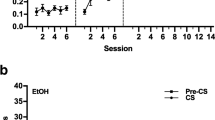Heading
Abstract
Rationale. We have previously reported that pretreatment with the corticosterone synthesis inhibitor ketoconazole blocks the electric foot-shock-induced reinstatement of cocaine-seeking behavior in rats, suggesting a potential role for the hypothalamo–pituitary–adrenal (HPA) axis in this animal model of relapse.
Objectives. This experiment was designed to investigate whether or not ketoconazole would also inhibit the reinstatement of cocaine seeking induced by the presentation of a conditioned reinforcer. The effects of the corticotropin-releasing hormone 1 (CRH1) receptor antagonist CP-154,526 were also investigated to further determine the involvement of the HPA axis in this behavior.
Methods. Adult male rats were implanted with jugular catheters and trained to self-administer cocaine (0.25 mg/kg per infusion) during daily 2-h sessions. During training, cocaine delivery was paired with the presentation of a tone and the illumination of a house light. Once a stable baseline of cocaine self-administration was observed, lever pressing was extinguished to less than 20% of baseline rates. During reinstatement testing, responding by rats in the contingent group resulted in the presentation of the conditioned reinforcer (i.e., the house light and tone previously paired with self-administered cocaine). Rats in the non-contingent group were presented with the tone/house light compound stimulus once every 5 min, regardless of responding. Rats were pretreated with ketoconazole (25 mg/kg, i.p.) or CP-154,526 (20 mg/kg, i.p.) 30 min prior to testing for reinstatement with the contingent presentation of the conditioned reinforcer to determine the role for the HPA axis in this behavior.
Results. The response-contingent presentation of the conditioned reinforcer reliably reinstated extinguished cocaine-seeking behavior, while the non-contingent presentation of the same stimulus did not. Increases in plasma corticosterone were evident during cocaine self-administration as well as during extinction and reinstatement testing. However, while plasma corticosterone returned to basal levels by the end of the session during extinction, it remained elevated through the end of the session during reinstatement. Pretreatment with ketoconazole reversed the conditioned reinforcer-induced reinstatement of extinguished cocaine-seeking behavior and also attenuated the conditioned increases in plasma corticosterone observed during reinstatement. Pretreatment with CP-154,526 resulted in a similar decrease in cocaine seeking.
Conclusions. These data suggest a potential role for the HPA axis in the ability of environmental cues to stimulate cocaine-seeking behavior.
Similar content being viewed by others
Author information
Authors and Affiliations
Additional information
Electronic Publication
Rights and permissions
About this article
Cite this article
Goeders, N.E., Clampitt, D.M. Potential role for the hypothalamo–pituitary–adrenal axis in the conditioned reinforcer-induced reinstatement of extinguished cocaine seeking in rats. Psychopharmacology 161, 222–232 (2002). https://doi.org/10.1007/s00213-002-1007-4
Received:
Accepted:
Issue Date:
DOI: https://doi.org/10.1007/s00213-002-1007-4




